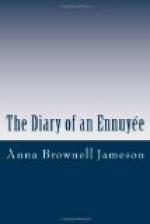Jan. 4.—We dispatched, as L** would say, a good deal to-day: we visited the Temple of Vesta, the Church of Santa Maria in Cosmadino, the Temple of Fortune, the Ponte Rotto, and the house of Nicolo Rienzi: all these lie together in a dirty, low, and disagreeable part of Rome. Thence we drove to the Pyramid of Caius Cestus.—As we know nothing of this Caius Cestus, but that he lived, died, and was buried, it is not possible to attach any fanciful or classical interest to his tomb, but it is an object of so much beauty in itself, and from its situation so striking and picturesque, that it needs no additional interest. It is close to the ancient walls of Rome, which stretch on either side as far as the eye can reach in huge and broken masses of brickwork, fragments of battlements and buttresses, overgrown in many parts with shrubs and even trees. Around the base of the Pyramid lies the burying-ground of strangers and heretics. Many of the monuments are elegant, and their frail materials and diminutive forms are in affecting contrast with the lofty and solid pile which towers above them. The tombs lie around in a small space “amicably close,” like brothers in exile, and as I gazed I felt a kindred feeling with all; for I, too, am a wanderer, a stranger and a heretic; and it is probable that my place of rest may be among them. Be it so! for methinks this earth could not afford a more lovely, a more tranquil, or more sacred spot. I remarked one tomb, which is an exact model, and in the same material with the sarcophagus of Cornelius Scipio, in the Vatican. One small slab of white marble bore the name of a young girl, an only child, who died at sixteen, and “left her parents disconsolate:”




